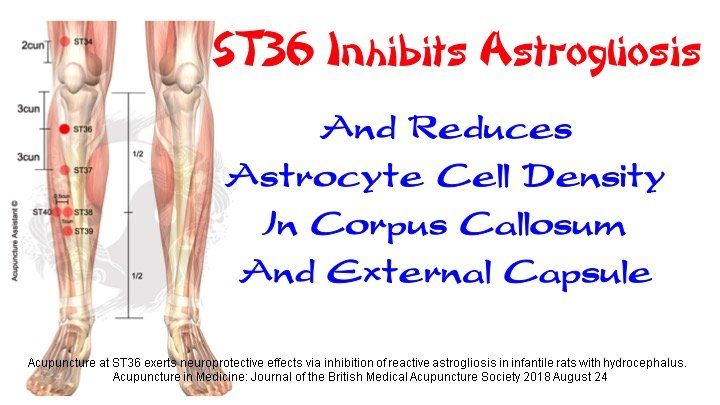Acupuncture Neuroprotective Effects
Comments by Dr. Mladenoff
Acupuncture was applied to ST36 once a day for 30 minutes for a total of 21 days. One significant observation that will have a significant bearing on a successful outcome is that acupuncture treatment was initiated within 1 day of inducing the brain lesion.
There was a reduction in reactive astrocyte cell density in the corpus collosum and external capsule.
The reason that this ability to alter this compromised corpus callosum structure is that there is a rotation injury that occurs at the corpus callosum in most concussion. (Research by David Camarillo Stanford University https://youtu.be/druJDI6hiiY)
Acupuncture at ST36 exerts neuroprotective effects via inhibition of reactive astrogliosis in infantile rats with hydrocephalus.
Jacqueline Atsuko Tida, Carlos Henrique Rocha Catalão, Camila Araújo Bernardino Garcia, Antônio Carlos Dos Santos, Carlos Ernesto Garrido Salmon, Luiza da Silva Lopes
Acupuncture in Medicine: Journal of the British Medical Acupuncture Society 2018 August 24
BACKGROUND: Acupuncture has been associated with improved cerebral circulation, analgesia, neuromodulatory function and neurogenesis. In particular, acupuncture at ST36 has been widely used in several central nervous system (CNS) disorders, including neurodegenerative diseases. However, its effects on hydrocephalus have not been studied. Our aim was to evaluate the effects of acupuncture at ST36 on behaviour, motor development and reactive astrogliosis in infantile rats with hydrocephalus.
METHODS: Hydrocephalus was induced in sixteen 7-day-old pup rats by injection of 20% kaolin into the cisterna magna. One day after hydrocephalus induction, acupuncture was applied once daily (for 30 min) for a total of 21 days in eight randomly selected animals (HAc group) while the remaining eight remained untreated (H group). An additional eight healthy animals were included as controls (C group). All animals were weighed daily and, from the fifth day after hydrocephalus induction, underwent MRI to determine the ventricular ratio (VR). Rats were also exposed to modified open-field tests every 3 days until the end of the experiment. After 21 days all the animals were euthanased and their brains removed for histology and immunohistochemistry.
RESULTS: Hydrocephalic rats showed an increase in VR when compared with control rats (P<0.01). In addition, these animals exhibited delayed weight gain, which was attenuated with acupuncture treatment. Hydrocephalic animals treated with acupuncture performed better in open field tests (P<0.05), and had a reduction in reactive astrocyte cell density in the corpus callosum and external capsule, as assessed by GFAP (glial fibrillary acidic protein) immunohistochemistry (P<0.05).
CONCLUSIONS: These findings indicate that acupuncture at ST36 has a neuroprotective potential mediated, in part, by inhibition of astrogliosis.
Acupuncture in Medicine: Journal of the British Medical Acupuncture Society 2018 August 24
BACKGROUND: Acupuncture has been associated with improved cerebral circulation, analgesia, neuromodulatory function and neurogenesis. In particular, acupuncture at ST36 has been widely used in several central nervous system (CNS) disorders, including neurodegenerative diseases. However, its effects on hydrocephalus have not been studied. Our aim was to evaluate the effects of acupuncture at ST36 on behaviour, motor development and reactive astrogliosis in infantile rats with hydrocephalus.
METHODS: Hydrocephalus was induced in sixteen 7-day-old pup rats by injection of 20% kaolin into the cisterna magna. One day after hydrocephalus induction, acupuncture was applied once daily (for 30 min) for a total of 21 days in eight randomly selected animals (HAc group) while the remaining eight remained untreated (H group). An additional eight healthy animals were included as controls (C group). All animals were weighed daily and, from the fifth day after hydrocephalus induction, underwent MRI to determine the ventricular ratio (VR). Rats were also exposed to modified open-field tests every 3 days until the end of the experiment. After 21 days all the animals were euthanased and their brains removed for histology and immunohistochemistry.
RESULTS: Hydrocephalic rats showed an increase in VR when compared with control rats (P<0.01). In addition, these animals exhibited delayed weight gain, which was attenuated with acupuncture treatment. Hydrocephalic animals treated with acupuncture performed better in open field tests (P<0.05), and had a reduction in reactive astrocyte cell density in the corpus callosum and external capsule, as assessed by GFAP (glial fibrillary acidic protein) immunohistochemistry (P<0.05).
CONCLUSIONS: These findings indicate that acupuncture at ST36 has a neuroprotective potential mediated, in part, by inhibition of astrogliosis.

